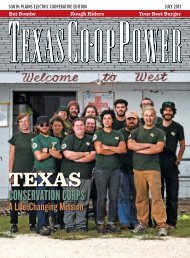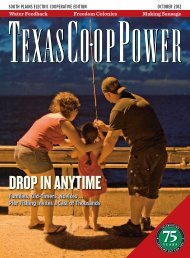November 2012PDF 5.57 MB - South Plains Electric Cooperative
November 2012PDF 5.57 MB - South Plains Electric Cooperative
November 2012PDF 5.57 MB - South Plains Electric Cooperative
Create successful ePaper yourself
Turn your PDF publications into a flip-book with our unique Google optimized e-Paper software.
Arwin J. ‘Jay’ Bowden of San Antonio participated in fierce fighting against the Japanese<br />
for control of Tarawa and used a bayonet to kill an enemy to save his own life. In<br />
such an adrenaline-charged moment, he said, ‘you don’t know where all your energy<br />
is coming from and you don’t remember where or when. Anyway, I survived.’<br />
Japan had built a landing strip on Tarawa’s main island and<br />
fortified it to the hilt. One Japanese commander said it would<br />
take “1 million men 100 years” to conquer Tarawa. “This was<br />
probably the most fortified 290 acres in the world,” Bowden said.<br />
Before dawn on <strong>November</strong> 20, 1943, Bowden was aboard a<br />
troop transport with about 2,000 Marines. He was among troops<br />
sent ashore on landing craft known as Higgins boats, but his<br />
boat got stuck on a reef. He and 32 other Marines boarded two<br />
amphibious track vehicles to get ashore. As they approached the<br />
beach, the Japanese blew up Bowden’s vehicle and killed most<br />
of the men who were with him.<br />
The fire burned off nearly all of Bowden’s clothes except his<br />
boots, knife belt and the leggings he wore under his uniform.<br />
His right ear was nearly burned off, as was most of his hair. He<br />
dove into knee-deep water and then hid with five other Marines<br />
behind a second vehicle. Near dusk, they decided their best<br />
hope was going into deeper water—to the reef about 500 yards<br />
out, where they hoped for a rescue.<br />
Earlier in the day, Bowden had picked up a waterlogged rifle<br />
that was useless except for the bayonet at the end. As they<br />
moved out, Japanese soldiers spotted them by the light of the<br />
fires on the island. “They came out and they were bayoneting<br />
and shooting everything that moved,” Bowden said. Several<br />
enemy soldiers came near, and Bowden somehow got close<br />
enough to one of the Japanese carrying a machine gun to plunge<br />
his bayonet into his chest.<br />
10 Texas Co-op Power <strong>November</strong> 2012<br />
Meanwhile, after 76 hours of fierce fighting, the Marines<br />
took the island but suffered more than 1,000 deaths and 2,000<br />
casualties, while the Japanese lost more than 4,600 troops.<br />
Bowden, 89, recovered after six weeks of medical care and<br />
returned to participate in other battles in the Pacific. After the<br />
war, he spent most of his work life at <strong>South</strong>western Bell. He is a<br />
widower and lives in San Antonio.<br />
‘I WAS THRILLED TO DEATH BECAUSE HE CAME BACK WHOLE’<br />
It was 1939 in a small town in Oklahoma when Marion Henegar, 21, married<br />
his sweetheart, Oletha, just 17. By 1943, Henegar had entered the Army Air<br />
Corps and spent three years as a radio operator on a C-47 that hauled supplies<br />
and paratroopers to the front lines in Europe.<br />
Oletha Henegar remembers the day her<br />
husband, Marion, came home after<br />
serving in the Army Air Corps: ‘We<br />
spent lots of time kissing and hugging,<br />
and we couldn’t keep our hands off<br />
one another.’ After 73 years of marriage,<br />
that still seems to be the case.<br />
To drop parachutists, Henegar’s aircraft often flew low, just<br />
650 feet above ground, plenty close enough to be shot down by<br />
the Germans. “When we got back, we’d count the holes in the<br />
planes,” Henegar said.<br />
For three years, Henegar and Oletha corresponded constantly.<br />
“We wrote sometimes once a day, sometimes two,”<br />
Oletha said.<br />
Near the end of the war, Henegar and his crew were assigned<br />
a new C-47. The only married one of the bunch, Henegar was<br />
given the honor of naming the plane. He chose “Little Oletha.”<br />
Henegar proudly showed a black-and-white photo of a strapping<br />
young man in a jumpsuit, standing under the plane with<br />
TexasCoopPower.com










